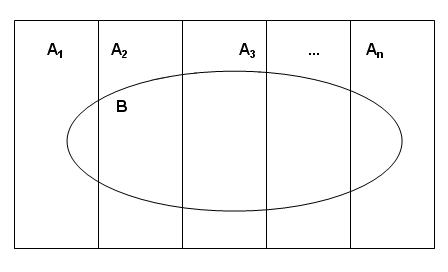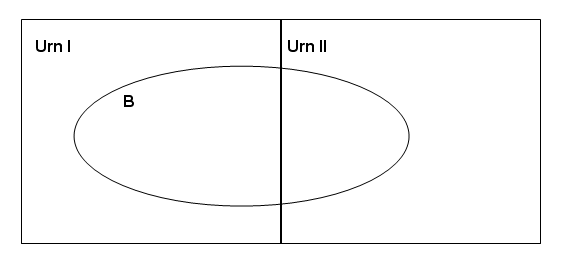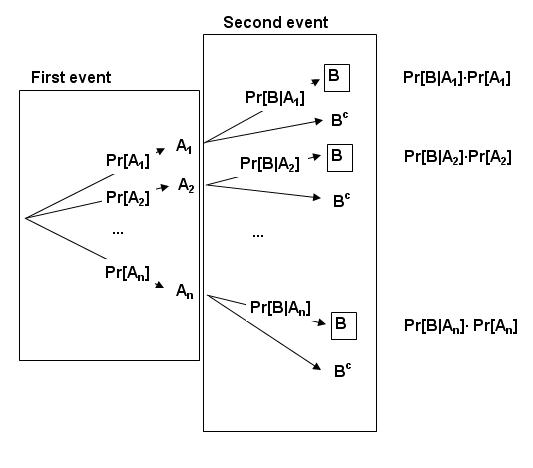Total probability
Bayes' law is tightly related with the law of total probability.
For example, let us view the exercise form previous lesson:
We have two urns, $\text{I}$ and $\text{II}$. Urn $\text{I}$ contains $2$ black balls and $3$ white balls. Urn $\text{II}$ contains $1$ black ball and $1$ white ball. An urn is drawn at random and a ball is chosen at random from it. What is the probability of choosing urn $\text{I}$ if the obtained ball is black?
It can be observed right away that the probability $\text{Pr}[B|\text{I}]=\frac{2}{5}$, where $B:=\text{"a black ball is drawn"}$ and $\text{I}:=\text{"urn I is chosen"}$. Thus, it is reasonable to use Bayes' law
$$\text{Pr}[\text{I}|B] = \frac{\text{Pr}[B|\text{I}]\cdot\text{Pr}[\text{I}]}{\text{Pr}[B]}$$
for answering the question. The probability $\text{Pr}[\text{I}]=\frac{1}{2}$, so only $\text{Pr}[B]$ is unknown. On order to understand the event $B$, let us draw the following diagram:
i.e. the event $B$ can happen in relation with urn $\text{I}$ or in relation with urn $\text{II}$. Hence, $$\text{Pr}[B]=\text{Pr}[(B\cap\text{I})\cup (B\cap\text{II})]=\text{Pr}[B\cap\text{I}]+ \text{Pr}[B\cap\text{II}],$$ since the events $\text{"black ball is drawn from urn I"}$ and $\text{"black ball is drawn from urn II"}$ are mutually exclusive.
This is precisely what the law of total probability says:
If $A_i$, where $i=1, 2, 3, \dots, n$, are pair vise mutually exclusive outcomes of an experiment/process
with random results, such that
$\text{Pr}[A_1]+\text{Pr}[A_2]+\text{Pr}[A_3]+\dots+\text{Pr}[A_n]=1$, then for any event $B$ that
happens in relation with the events
$A_i$, we have
$$\text{Pr}[B]=\text{Pr}[B\cap A_1]+\text{Pr}[B\cap A_2]+\text{Pr}[B\cap A_3]+\dots +\text{Pr}[B\cap A_n]=
\sum_{i=1}^n\text{Pr}[B\cap A_i].$$
Diagram:

In our example, $n=2$, $A_1=\text{I}$, and $A_2=\text{II}$. One of two urns is chosen, thus the events are mutually exclusive. Note that $\text{Pr}[\text{I}]+\text{Pr}[\text{II}]= \frac{1}{2}+ \frac{1}{2}=1$. We already obtained, that
$$\text{Pr}[B]=\text{Pr}[B\cap\text{I}]+\text{Pr}[B\cap\text{II}].$$
Actually, in order to calculated the probability, we can give to the formula also an alternative form. Just let us take into account that the events $B$ and $\text{I}$, and also the events $B$ and $\text{II}$ are not independent, in which case $\text{Pr}[B\cap\text{I}]= \text{Pr}[B|\text{I}]\cdot\text{Pr}[\text{I}]$ and $\text{Pr}[B\cap\text{II}]= \text{Pr}[B|\text{II}]\cdot\text{Pr}[\text{II}]$. By replace these equalities into the formula:
$$\text{Pr}[B]=\text{Pr}[B\cap\text{I}]+\text{Pr}[B\cap\text{II}]= \text{Pr}[B|\text{I}]\cdot\text{Pr}[\text{I}]+\text{Pr}[B|\text{II}]\cdot\text{Pr}[\text{II}].$$
Thus, $\text{Pr}[B]=\frac{2}{5}\cdot\frac{1}{2}+\frac{1}{2}\cdot\frac{1}{2}=\frac{9}{20}$.
Alternatively, the law of total probability can be written $$\text{Pr}[B]=\text{Pr}[B|A_1]\cdot\text{Pr}[A_1]+\text{Pr}[B|A_2]\cdot\text{Pr}[A_2]+\dots +\text{Pr}[B|A_n]\cdot\text{Pr}[A_n]= \sum_{i=1}^n\text{Pr}[B|A_i]\cdot\text{Pr}[A_i].$$ The illustrative diagram:
What is the probability that $y=1$, where $y$ is evaluated randomly by one element from the list $A$ following the algorithm below?
let us choose $x$ randomly from $\{0, 1, 2\}$
if $x=0$, let $A=(1,0,0,0)$
if $x=1$, let $A=(1,0,0,0,0,0,0,0,0,0)$
if $x=2$, let $A=(1,1,0,0,0,0,0)$
$y\leftarrow A$
As you all know, information is transmitted digitally as a binary sequence (bits). However, noise on the channel corrupts the signal, in that a digit transmitted as $0$ is received as $1$ with probability $1 −\alpha $ , with a similar random corruption when the digit $1$ is transmitted. It has been observed that, across a large number of transmitted signals, the $0$s and $1$s are transmitted in the ratio $3 : 4$.
Given that the sequence $101$ is received, what is the probability distribution over transmitted signals? Assume that the transmission and reception processes are independent.
Hint: “the $0$s and $1$s are transmitted in the ratio $3 : 4$” tells us, that in general out of seven bits four are $1$s. The task should be solved under the assumption that all the sent bits are independent.


